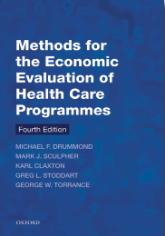Methods for the economic evaluation of health care programmes
(fourth edition)
The fourth edition of the popular textbook, Methods for the Economic Evaluation of Health Care Programmes reflects the major changes that have occurred in the methods and application of economic evaluation in recent years.
The methods themselves have moved on in the 10 years since the last edition. The new edition reflects these changes. Chapters 5 and 6, on measuring and valuing effects reflect the growth in the literature on the measurement of health gain and other benefits of health care, in particular the methodological work on quality-adjusted life-years and the growing use of conjoint analysis. In addition, two new chapters (10 and 11) are included, discussing the methods of evidence synthesis and characterising uncertainty, given their growing importance in economic evaluation, within the context of the growing acceptance and application of decision-analytic modelling.
However, considering both the last 10 years and 28-year period since the original publication of the book, the most fundamental change relates to the role of economic evaluation in healthcare decision-making. In the first edition, back in 1987, the emphasis was on explaining the methods used in economic evaluations so that readers could critically appraise them and potentially embark on their own studies. As the role of economic evaluation in decision-making expanded, a chapter on ‘Presentation and use of economic evaluation results’ was added, discussing the use of cost-effectiveness thresholds and the transferability of data from one setting to another. However, in discussing the content of the fourth edition, it became apparent that this was no longer sufficient because of the international growth in the use of economic evaluation. Rather, the use of particular methods would be best discussed in the context of the decision problem being faced. The issue for most decision-makers is no longer ‘should we use economic evaluation?’, but ‘how do we best use it in our setting?’
Therefore, in this edition two new chapters (2 and 4) have been added which emphasise that, in health care decision-making, it is important to be clear on what we are trying to maximise (for example, health or welfare), the constraints that we face and the importance of opportunity cost. This opens up the possibility to give additional insights on the role of the various analytic approaches, given the particular decision-making context. In essence, the choice of methods and the use of study results are now integrated throughout the book, rather than being discussed in separate chapters.
This all amounts to a revised book, with a new structure and around 45% new material. Readers should find that the new edition represents an improvement on previous editions and that it will stimulate further advances in both methods and decision-making processes in the future.
Methods for the economic evaluation of health care programmes (fourth edition)
- Authors:
Michael Drummond
Mark Sculpher
Karl Claxton
Greg Stoddart
George Torrence- Publisher:
Oxford University Press- Year:
2015
Order this book


